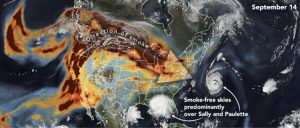Scientists advocate breaking laws – of geography and ecology
by Sue Nichols, Michigan State University
2/2/2021
Recent global calamities – the pandemic, wildfires, floods – are spurring interdisciplinary scientists to nudge aside the fashionable First Law of Geography that dictates “everything is related to everything else, but near things are more related than distant things.”

California fires meet hurricanes, September 2020. Courtesy of NASA Earth Observatory, Joshua Stevens & MSU.
Geography, and by association, ecology, has largely followed what’s known as Tobler’s Law, which took hold in the early 1970s. But then came the novel coronavirus apparently has leapt from wildlife meat markets in China to the world in a matter of months. Global climate change creates conditions ripe for infernos in the North American west and Australia. Extreme Ohio flooding in 2018 gave way to sediments and excessive nutrients to dump into the Gulf of Mexico to the tune of some 300 square kilometers.
In other words, all that’s local is a lot more global, and the scientists in this week’s Frontiers in Ecology and the Environment say solutions can only be found through broader views and collaborations nearby and far away.
“Understanding and finding solutions to the recent and future crises need an integrated framework across local to global scales,” said Jianguo “Jack” Liu, Michigan State University’s (MSU) Rachel Carson Chair in Sustainability.
Read more here: https://www.unr.edu/nevada-today/news/2021/macrosystems-biology
Read the Frontiers in Ecology and the Environment paper: https://esajournals.onlinelibrary.wiley.com/doi/full/10.1002/fee.2289